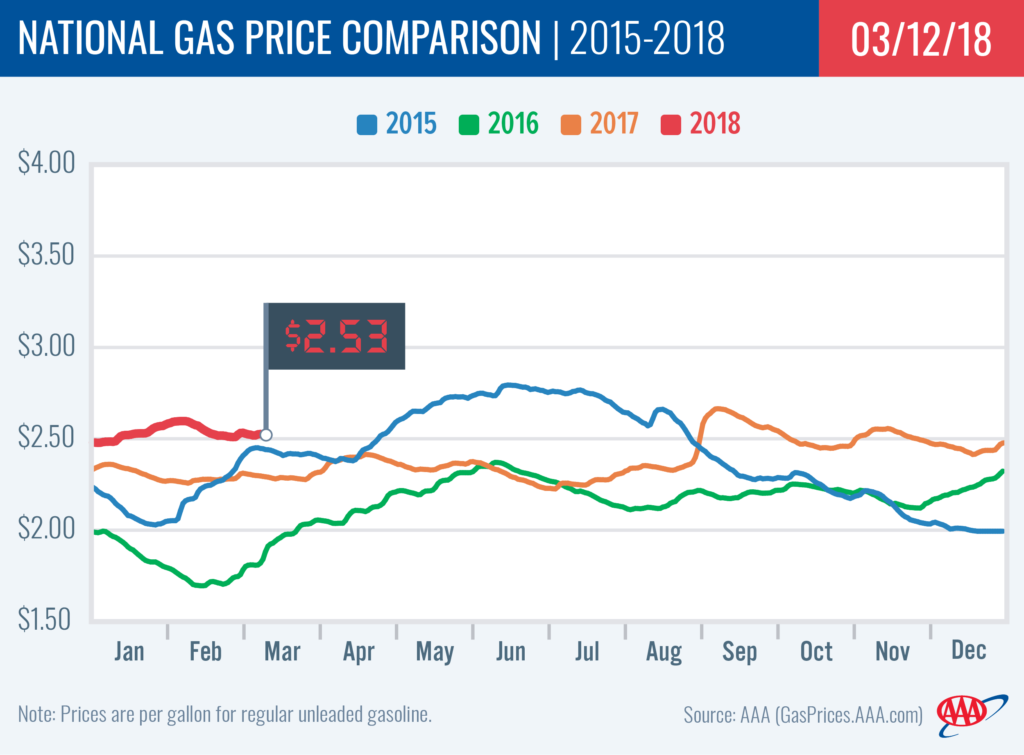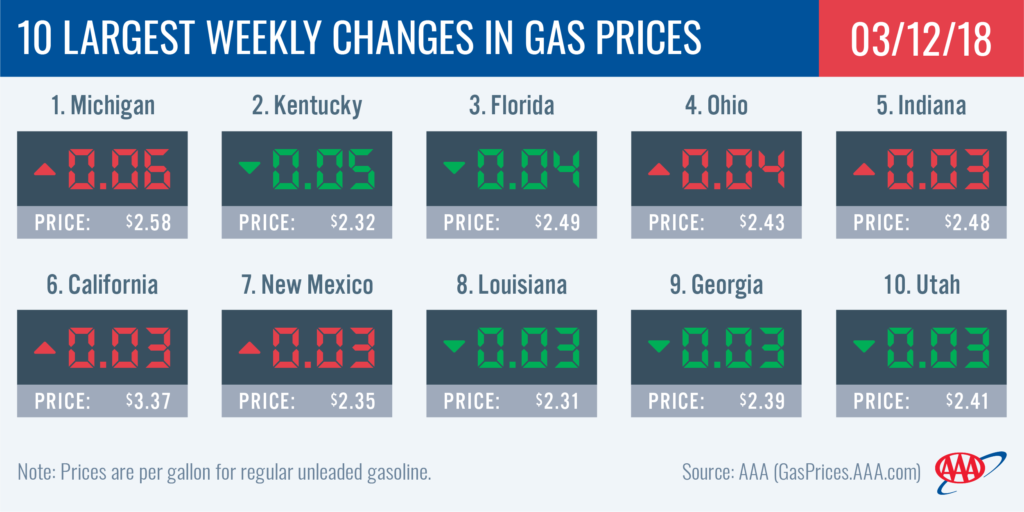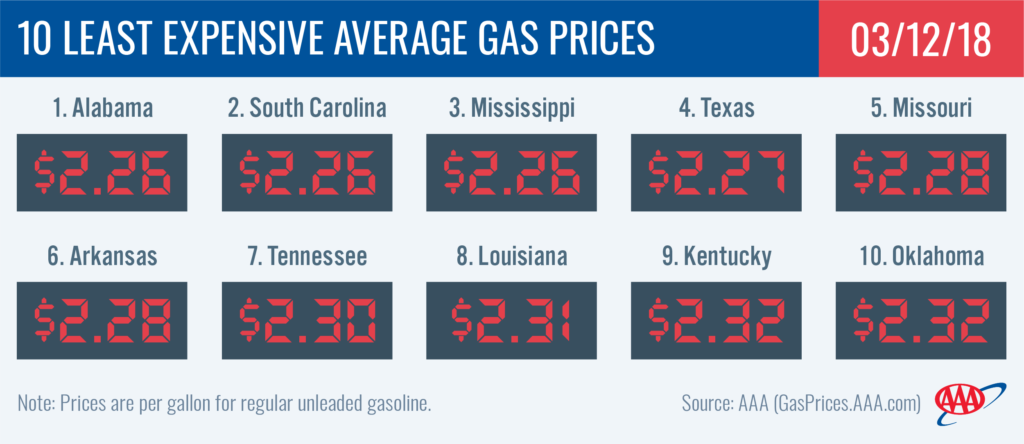At $2.53, the national gas price average has held steady for nine days. Factors contributing to the flat price include increased gasoline production that has kept pace with higher than usual demand this winter. The latest Energy Information Administration (EIA) report shows that demand increased week-over-week, registering at 9.2 b/d – the highest gasoline demand level seen this year.
“On the week, the majority of motorists are paying less at the pump with 67 percent However, the West Coast, Great Lakes and Central states are mostly seeing a gas price increase.”
Today’s national average is a nickel less than last month, but 13 cents more than one year ago.
Quick Stats
- The largest weekly changes are: Michigan (+6 cents), Kentucky (-5 cents), Florida (-4 cents), Ohio (+4 cents), Indiana (+3 cents), California (+3 cents) and New Mexico (+3 cents), Louisiana (-3 cents), Georgia (-3 cents) and Utah (-3 cents).
- The nation’s top ten least expensive markets are: Alabama ($2.26), South Carolina ($2.26), Mississippi ($2.26), Texas ($2.27), Missouri ($2.28), Arkansas ($2.28), Tennessee ($2.30), Louisiana ($2.31), Kentucky ($2.32) and Oklahoma ($2.32).
West Coast
Pump prices in the West Coast region are among the highest in the country: Hawaii ($3.50), California ($3.37), Alaska ($3.06), Washington ($3.01), Oregon ($2.92) and Nevada ($2.81). On the week, California, Oregon and Nevada saw the largest jumps, increasing by two cents each. Washington inched up by a penny, while the remaining states stayed the same.
According to the EIA, gasoline inventories saw a 1.2 million bbl build last week – the largest increase in nearly two months. Total gasoline stocks in the region sit at 34.4 million bbl, which is approximately 4 million bbl more than the level at this time last year.
Great Lakes and Central
The Great Lakes and Central states saw the most volatility with gas prices increasing 6 cents in one state and decreasing 5 cents on the week in another: Michigan (+6 cents), Kentucky (-5 cents), Ohio (+4 cents) Indiana (+3 cents), and Kansas (-3 cents). In addition, Wisconsin (+1 cent) motorists are paying more. Gas prices are cheaper for all other states in the region.
After last week’s substantial 1.7 million bbl build, gas inventories added 880,000 bbl this week according to the EIA. Total inventories sit at 61 million bbl. The last time the region reached or was above 61 million bbl was in 2016, according to the EIA. It was reported that PBF Energy’s 188,000-b/d refinery in Toledo, Ohio, shut its hydrocracker for planned maintenance last week. A hydrocracker breaks up oil into a variety of byproducts, including gasoline. This could affect regional inventory levels through April, which is when the refinery expects to complete maintenance.
South and Southeast
Prices at the pump are cheaper for every state in the South and Southeast except for New Mexico (+3 cents). Florida (-4 cents) saw the largest drop. Seven of the country’s top 10 states with the cheapest gas price average are in this region: Alabama ($2.26), South Carolina ($2.26), Mississippi ($2.26), Texas ($2.27), Arkansas ($2.28), Louisiana ($2.31) and Oklahoma ($2.31).
Compared to one month ago, gas prices are 4 to 15 cents cheaper. Florida (-15 cents) is seeing the biggest price drop in the region and the country.
At 85.7 million bbl, gasoline inventories in the region are at the second-highest total on record, according to EIA data. If the region builds on current levels this coming week, the record of 85.9 million, set in January 2017, could be broken.
Mid-Atlantic and Northeast
Across the Mid-Atlantic and Northeast region, gas prices dropped as much as 3 cents on the week with Pennsylvania and Delaware landing on this week’s top 10 states list with the biggest decreases. In the region, gas prices range from as low as $2.30 in Tennessee to as expensive as $2.76 in Pennsylvania.
Despite this week’s pump price decreases, all states in the region are paying more than at the same time last year. However, a handful are paying as much as 25-cents or more to fill up versus March 2017: Massachusetts (+31 cents), Rhode Island (+30 cents), Vermont (+30 cents), New Jersey (+29 cents), Connecticut (+29 cents), Washington, D.C. (+28 cents), New Hampshire (+28 cents), Pennsylvania (+26 cents), New York (+26 cents), Maine (+26 cents) and West Virginia (+25 cents).
Gasoline inventories took a large 3.4 million bbl draw on the week, according to the EIA. Regional inventory sits at 61.8 million bbl. The draw is not surprising given an increase in U.S. exports and that local Phillips 66 Bayway refinery continues maintenance.
Rockies
Motorists in the Rockies region continue to see gas prices decline. With a 3-cent drop, Utah saw the biggest change on the week in the region and is among the top 10 states in the country. Gas prices are 2 cents cheaper in Idaho and one cent cheaper in Colorado and Wyoming. At $2.59, Montana’s average was stable on the week and continues to sell the most expensive gas in this five-state region.
Utah (-2 cents) is the only state in the country paying less at the pump compared to this time last year. Montana (+23 cents) is paying the most year-over-year.
With a 700,000 build, gasoline inventories register at 8.2 million bbl. This is on par with levels this time last year.
Oil market dynamics
At the close of Friday’s formal trading session on the NYMEX, WTI increased $1.92 to settle at $62.04. Earlier in the week, after EIA’s weekly report noted that crude oil inventories increased by 2.4 million bbl last week, WTI prices took a hit. Crude prices rebounded toward the weekend because of a strong rally alongside the stock market. The price of crude has the potential to slide this week amid the fact that U.S. crude production continues to boom.
Crude production hit another record at 10.37 million b/d last week. Market observers are likely to continue watching this number to see if it begins to outpace domestic and global crude oil demand. According to Baker Hughes, the U.S. lost four active oil rigs last week. The current total stands at 796, which is 179 more than last year’s count at this time.
Motorists can find current gas prices along their route with the free AAA Mobile app for iPhone, iPad and Android. The app can also be used to map a route, find discounts, book a hotel and access AAA roadside assistance. Learn more at AAA.com/mobile.



